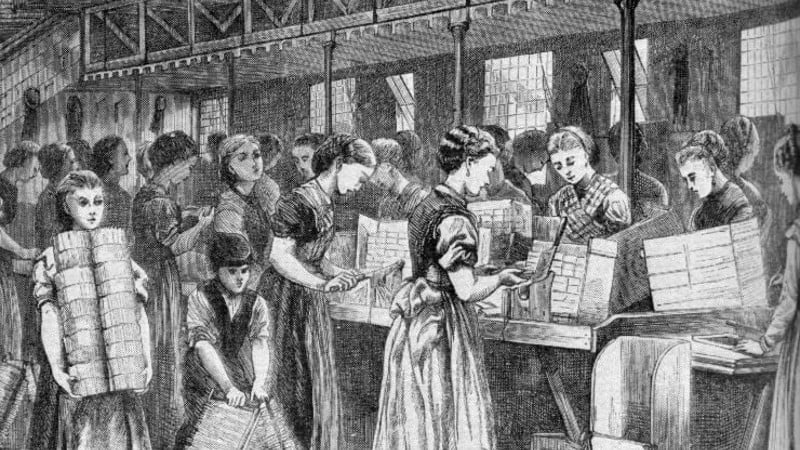The True Story About Matchgirls’ Strike from Enola Holmes 2 Explained

One of the things that we saw in Netflix’s Enola Holmes 2 was the fact that Enola took on a case involving a missing young girl right at the time when she was about to quit her job as a private detective. In that regard, Enola got herself involved in a larger scheme of corruption and poor working conditions in a match factory. The storyline culminated in the event that is historically known as the Matchgirls’ Strike of 1888. So, what is the Matchgirls’ Strike about?
The Matchgirls’ Strike of 1888 was an industrial strike involving teenage girls and young women that were forced to work under poor working conditions in a match factory in Bow, London, during the end of the 19thcentury. This strike is one of the most important moments in the history of labor rights.
Even though Enola Holmes may be a fictional story, the fact that a historic moment was included in the second installment of the movie franchise made the film much more intriguing to those who know a thing or two about history. Of course, not a lot of people are aware of how important the Matchgirls’ Strike is, and that’s what we are here to talk about.
Is Enola Holmes 2 Based On A True Story?
Enola Holmes 2 looked to build on the storyline that had already been established by the first Enola Holmes movie, as this film focused more on the budding detective career of Enola, the youngest sister of Sherlock Holmes. Of course, things didn’t start out well for Enola because of the fact that she was sort of failing as a detective because people didn’t trust her youth and the fact that she was a woman. Nevertheless, she found herself getting involved in a case when a young girl named Bessie sought her help in a case involving her missing older sister.

In that regard, Enola Holmes got herself involved in a larger conspiracy of events that focused more on the working conditions of the girls that were employed by a local match company in London. She found out that the missing girl had been snooping around the match factory and suddenly disappeared the moment she learned a dark secret regarding the factory itself. And that was when Enola found out that the missing girl, named Sarah Chapman, was actually working in secret to bring down the factory due to the fact that there was corruption involved in it.
With the help of her older brother Sherlock, who was working on a case that was connected to the Sarah Chapman case, Enola was able to discover that the owner of the match factory had secretly changed the formulation of the phosphorous used in the matches so that he could use a cheaper one of worse quality. And this new formula actually had health hazards that led to the matchgirls getting sick with a deadly disease called typhus while they were at work.
In relation to that, Enola was able to crack the case but lost the only proof that could have helped them bring down the corruption going on in the match factory. But the good thing was that Sarah Chapman returned to the factory to lead the girls to a strike.
As it turned out, while Enola Holmes 2 is a work of fiction that’s based on a fictional book, the Matchgirls’ Strike, led by Sarah Chapman, is a true historical event that happened near the end of the 19th century. However, the difference here is that Enola Holmes and the entire scheme of corruption that was shown in the movie are works of fiction. Nevertheless, the entire strike that the matchgirls instituted is a true story.
Matchgirls’ Strike Explained
We established that the Matchgirls’ Strike instituted by Sarah Chapman during the events of Enola Holmes 2 is a true historical event. Nevertheless, there are a lot of differences between the events in Enola Holmes 2 and what really happened in history. So, what really happened in the Matchgirls’ Strike?
It was in 1888 when teenage girls and young women working for the Bryant and May match factory actually instituted an industrial action in response to the poor working conditions that they were experiencing in the match factory. Bow, London was a poverty-stricken area in the city at that time, and Bryan and May realized that they were able to make money by taking advantage of the need of teenage girls and young women to make ends meet.

The Bryant and May factory had become quite known among the locals for the poor working conditions in the environment, and that was when the women had enough of their situation, considering that what they were earning was no longer commensurate with the hazards and the different conditions that they had to endure while they were working.
They claimed that, as early as 6:30 in the morning, they had to work for 14 hours in a dangerous workplace that was physically demanding for them. On top of that, they only had two scheduled breaks and were forced to sacrifice toilet breaks because of the fact that any unscheduled toilet breaks would be deducted from their small wages. They were barely able to live on the wages they were earning, and that meant that they couldn’t sacrifice any penny just so they could go to the toilet. And the worst part was that the company was basically profiting off of their poor working conditions and the health hazards that the women had to endure.
Speaking of health hazards, these women were exposed to white phosphorus on a daily basis, and this was what led to severe health problems. In Enola Holmes 2, the women were exposed to a condition called typhus while they were at work. Meanwhile, in the true historical event, the women were exposed to a condition called phossy jaw, which led to tooth loss and swelling of the gums, among other symptoms, when they inhaled white phosphorus, which was cheaper for the company and was more profitable for the owners and the shareholders.
The girls were also forced to provide their own supplies, such as the boxes and paint they used for the matches. They were also forced to pay the boys who were providing the frames for the boxes used for the matches. As such, at the end of the day, they couldn’t even get anything out of the wages that they were paid.
As such, in 1888, around 1,400 women refused to show up for work on the first day of the strike, as it only took a matter of days for the entire factory to cease operations due to the lack of workers. The workers, of course, had a lot of demands from the company, such as the abolishment of the fines. They were also allowed to take their breaks in a separate room where they wouldn’t be able to ingest white phosphorus while they were eating.
Then, in 1901, the Bryan and May company eventually stopped using white phosphorus. Seven years later, there was a law was passed to prohibit the use of white phosphorus. The 1906 Berne Convention also banned the worldwide use of this substance for matches because of the health hazards connected to it.
As such, this was a seminal moment in the history of labor because of the fact that the women were able to band together to demand better working conditions on their part. This allowed the world to realize how bad their working conditions were and how hazardous white phosphorus was to anyone regularly exposed to it.
Of course, the leader of this movement was Sarah Chapman, who was the very same person that the Enola Holmes 2 Sarah Chapman was based on. So, while Sarah in the movie isn’t exactly the same as the one in real life, the film was able to open the eyes of different movie audiences to a true historical event that showcased the power of women that wanted change.

